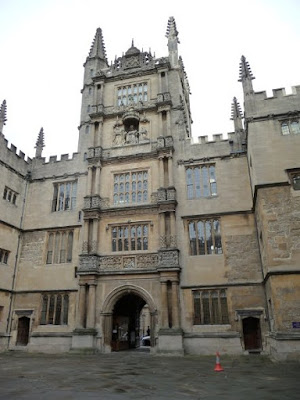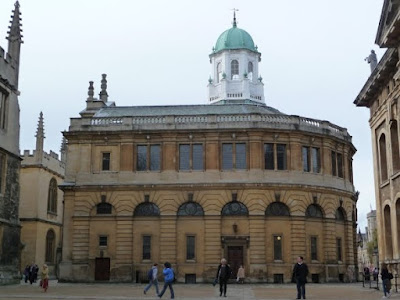
Bodleian court
 |
Metaphysician, heal thyself; I am quite sure we have pix (35mm) of me in roughly this pose, and exactly this place, from 1979, 1989, and 1998 |
 |
Hall at Bodleian; note fan vaulting; I understand some of the Harry Poppins series was shot here |
 |
The Ashmolean was closed for renovations |
 |
Evidently, they punt here too, just as in upstart Cambridge |
 |
Magdalen College |
 |
All Souls |
 |
Sheldonian Theatre |
 |
Radcliffe Camera |
 |
Lincoln College |
Vicki adds:
Oxford, England October 21, 2009
We had a wonderful day in Oxford today with temps in the 50s and some sun. The place was very busy even when not tourist season because, of course, all the students are there. We went on the tour of the Bodelian Library, which was very exciting for me since this is my fourth trip to Oxford and the library has always been closed before for special events. Our guide was an elderly, very British chap who bored everyone to death but me. The introductory lecture before the tour lasted about 25 minutes, followed by a 35 minute tour! The gift shop had some wonderful new things (it had been open in the past and I had availed myself of it.) Unfortunately, what I decided I wanted was the "Silence Please" jug but they sold their last one yesterday! Oh well.
Then we went to 4 used book stores and bought about 10 books--which we should not have as our camper is already overweight. Mark and I are not very good at resisting books, even with the e-book. We have been completely spoiled by UK--being able to buy books, read directions on food packages, read the labels in the museums, ask directions (lost 3 times today in Oxford, etc. If it wasn't getting so cold, we would definitely stay longer. As it is we are changing the next couple of weeks around. We had planned to go from Oxford over to the southwest, then back through the middle south, a week or so in London, and then finish in the southeast. However, the National Trust closes almost all its properties on Nov. 1 for the winter. There are 3-4, including Churchill's home, that we don't want to miss, so tomorrow we are driving straight around London to the south and southeast. Then we will double back to the southwest and finish in London in November.
Oxford, England October 21, 2009
We had a wonderful day in Oxford today with temps in the 50s and some sun. The place was very busy even when not tourist season because, of course, all the students are there. We went on the tour of the Bodelian Library, which was very exciting for me since this is my fourth trip to Oxford and the library has always been closed before for special events. Our guide was an elderly, very British chap who bored everyone to death but me. The introductory lecture before the tour lasted about 25 minutes, followed by a 35 minute tour! The gift shop had some wonderful new things (it had been open in the past and I had availed myself of it.) Unfortunately, what I decided I wanted was the "Silence Please" jug but they sold their last one yesterday! Oh well.
Then we went to 4 used book stores and bought about 10 books--which we should not have as our camper is already overweight. Mark and I are not very good at resisting books, even with the e-book. We have been completely spoiled by UK--being able to buy books, read directions on food packages, read the labels in the museums, ask directions (lost 3 times today in Oxford, etc. If it wasn't getting so cold, we would definitely stay longer. As it is we are changing the next couple of weeks around. We had planned to go from Oxford over to the southwest, then back through the middle south, a week or so in London, and then finish in the southeast. However, the National Trust closes almost all its properties on Nov. 1 for the winter. There are 3-4, including Churchill's home, that we don't want to miss, so tomorrow we are driving straight around London to the south and southeast. Then we will double back to the southwest and finish in London in November.







































